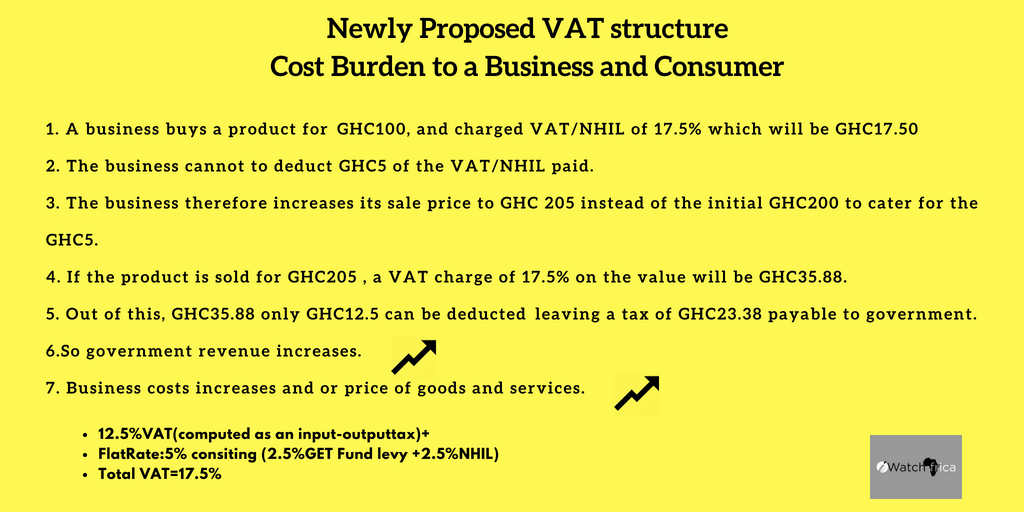
Fact-Check: Businesses to incur 5% VAT cost despite government claims that VAT has not been increased
Tracking government commitments
iWatch Africa assessment of the newly proposed Valued Added Tax (VAT) structure can confirm that businesses will incur a tax burden of 5% despite claims by the government that VAT has not been increased under the proposed VAT structure.
The Finance Minister, Mr. Ken Ofori-Atta, during his presentation of the mid-year budget review on July 19th 2018 stated, “I wish to assure the House that VAT will not be increased despite some economic challenges,”a claim iWatch Africa finds misleading.
Mr. Ofori- Atta subsequently announced that the Health Insurance Fund Levy and the GETFund components from the VAT have been separated and will now have straight levies of 2.5 percent respectively.
iWatch Afrca assessment of the proposed VAT structure has revealed that though the marginal rate of VAT under the proposed structure remains 17.5%, businesses will be burdened with an additional 5% cost under the proposed structure.
Current VAT structure
15% VAT (including 2.5% GETFund component) and 2.5% NHIL (all based on input-output tax calculations) = 17.5% VAT
Under the current VAT structure, if a business purchases a product for GHC100, the business will be charged VAT of 17.5% on the value of the item which will be GHC17.50. A VAT registered business has the opportunity to offset his input VAT against his output VAT and pay the difference to the government. Meaning, If the business sells the product for GHC200, it is expected to charge 17.5% on the value of the item which will be GHC35 (17.5% *GHC 200). Based on the VAT regulations, the business can deduct the GHC17.5 paid on its initial VAT payment from the GHC35 collected from the customer and pay the difference i.e GHC17.5 to government.
Newly Proposed VAT Structure
12.5% VAT (computed as an input-output tax) + 2.5% GETFund levy (based on transaction values) + 2.5% NHIL (based on transaction values)
The minister, Ken Ofori Atta stated that under the newly proposed VAT structure, the government will be converting the GETFund of 2.5% on the VAT to a straight levy of 2.5%. Additionally, there will also be the conversion of the NHIS of 2.5% on VAT to a straight levy.
What this means is that, the government now says it wants to make 5% (NHIL+GETFund) of the 17.5% VAT a flat rate tax. This means businesses cannot deduct this 5% component of the VAT incurred on their purchases. Therefore, based on the above example, instead of deducting GHC17.5 from GHC35, businesses can only deduct GHC12.5 from the GHC35 and will have to give GHC22.5 to the government compared to the GHC 17.5 they would have paid previously, incurring an additional business cost of GHC5.
Meanwhile, renowned Economist, John Gasti has agreed with iWatch Africa’s position arguing that, Ghanaians will now pay more for goods and services, following government’s decision to levy both the NHIL and GETfund.
“The burden of the people has been increased in disguise. What it means is that the flat rate is going to impose more burden on Ghanaians,” Mr. Gatsi stated.
Implications for businesses and consumers

By restricting the amount of input tax businesses are allowed to deduct, government has found a way of increasing revenue, even though the marginal rate of VAT remains the same. Most business will have to decide whether to absorb this extra 5% charge, eating into their profit margins or pass this on to the consumer although the latter is more likely to be the case as businesses are assumed to be rational institutions.
It is expected that if the newly proposed VAT structure is approved by the parliament of Ghana, prices of goods and services would definitely go up while government revenue increases.
Report by Gideon Sarpong | Policy and News Content Director | iWatch Africa


